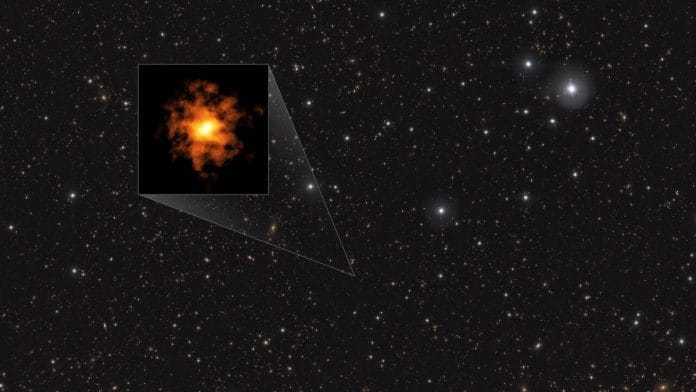New Delhi: A team of scientists, led by Lucie E. Rowland of Leiden University in The Netherlands, has discovered the most distant Milky Way-like galaxy ever observed. Named REBELS-25, the galaxy is disc-shaped and strongly rotation-oriented, with spiral arms and an elongated central bar just like the Milky Way.
The scientists made the discovery with the Atacama Large Millimeter/submillimeter Array (ALMA), an international astronomy facility in Chile.
The study describing the findings was published Monday in the journal Monthly Notices of the Royal Astronomical Society.
Light emitted by the galaxy that reached the Earth is from when the universe was 700 million years old, implying that REBELS-25 took 700 million years or less to evolve, the study said.
For context, the current age of the universe is 13.8 billion years, and that of the Milky Way is 13.6 billion years.
According to existing theories, early galaxies are messy, chaotic and not well-designed the way the Milky Way is, which took 13.6 billion years to reach its current ordered state.
However, REBELS-25 is very similar in characteristics to the Milky Way, leading scientists to reexamine their theory about the timescale on which galaxies develop is. Read more here.
Also Read: Dolphins smile at each other during social play & Antarctica is ‘greening’ at dramatic rate
73% decline in wildlife populations
There has been a 73 percent decline in the monitored wildlife population sizes globally from 1970 to 2020, according to the World Wide Fund for Nature (WWF)’s Living Planet Report released Thursday.
The biggest threat to wildlife populations worldwide, according to the report, is habitat loss and degradation.
The strongest decline in wildlife over the aforementioned 50 year-period occurred in freshwater ecosystems, where there was an 85 percent decline in monitored populations.
The change reported is in terms of the average size of the populations of different species, and not absolute numbers.
In India, certain species, including vultures, saw an 89 percent decline in their populations in a mere 20-year period from 2002 to 2022, it said. A large part of this, the report explained, was driven by climate change and ecological degradation, and without active conservation efforts, we would be unable to stop the rapid loss of nature. Read more here.
2800-yr-old burial unearthed in Siberia
In southern Siberia, a 2800-year-old burial excavated by archaeologists showed a striking resemblance to the burial rituals of the Scythians—nomadic people of eastern Iranian descent who lived between 2,700 and 2,300 years ago in what is now Crimea.
In a study published Tuesday in the journal Antiquity, Russian scientists explained the elaborate 2800-year-old burial, as part of which a person who was probably important was buried alongside 18 horses and a woman, purportedly as a human sacrifice.
The study said carbon dating of exact clusters in which human and horse bones were found along with weapons, beads and headgear showed that the remains were from 900 BC.
The scientists pointed out that the pattern in which the bones were distributed, and decorations on the headgear and weapons, all resembled how Scythian culture was described by Greek historian Herodotus in his book The Histories.
The paper also said that it is quite rare to find evidence of Scythian culture in a time period before their empire, and in a region beyond their extent. However, the authors said that the findings serve as evidence of cross-cultural links between East and Central Asia, and are indicative of the possible origins of the Scythian community. Read more here.
Can fungi recognise shapes? New study says yes
Scientists from Japan have conducted a study to assess whether fungal spores have the cognitive capacity to differentiate between shapes, even though they technically do not have brains. To find this, the researchers conducted an experiment in which they gave the same type of wood-decaying fungi two differently shaped blocks of wood to grow on.
The study will appear in the December 2024 edition of the journal Fungal Ecology.
The scientists observed whether the fungal spores used the same method to spread in both wooden blocks irrespective of their shape. To their surprise, the scientists saw that in the cross-arrangement block of wood, the fungal spores had stronger connections in the outermost regions of the block, and weaker ones in the middle. Meanwhile, in the circular piece of wood, the fungal spores the strengths of the connections were similar throughout.
This, according to the scientists, was an indication of ‘decision making’ by the fungi, wherein each spore communicates with the other to decide how to spread to maximise benefit. Read more here.
(Edited by Radifah Kabir)






